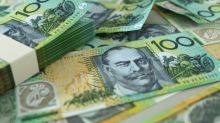AUD/USD (AUDUSD=X)
CCY - CCY Delayed price. Currency in USD
Add to watchlist
At close: 05:50AM BST
| Previous close | 0.6523 |
| Open | 0.6535 |
| Bid | 0.6535 |
| Day's range | 0.6535 - 0.6535 |
| 52-week range | 0.6272 - 0.7092 |
| Ask | 0.6531 |
 FX Empire
FX EmpireAUD/USD Weekly Price Forecast – Aussie Powers Higher For The Week
The Australian dollar has seen a lot of noisy behavior, as recovery was on the menu this past week. At this point, we are in the middle of the overall consolidation area that has been so important in this pair.
 FX Empire
FX EmpireAUD/USD Forecast – Aussie Continues to Swim Upstream
The Aussie dollar rallied on Friday, as we continue to see it swim upstream. The market was strong in the early hours of Friday but finds itself in the middle of the previous consolidation area.
 FX Empire
FX EmpireAUD/USD Forecast – Aussie Continues to Attempt a Move Higher
The Aussie continues to see attempts to rally, as the market has possibly been overstretched to the downside. The market now look as if it is going to be running into a bit of trouble.